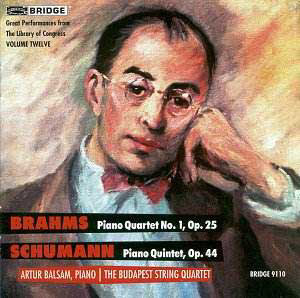A portrait of Artur Balsam stares from the cover of
Volume 12 in Bridge’s series of live performances from the Coolidge
Auditorium of The Library of Congress. He had first joined the Quartet
for a performance in 1946 and it was in 1951 that he rejoined them,
and again in 1953, the results of which collaboration are preserved
here (the other piece played that day in 1951 was the Shostakovich Piano
Quintet Op 57 – which I hope will make a future appearance in the series).
Balsam was active as an accompanist at the Library
– a recital with Nathan Milstein is on Bridge 9066 and in the Brahms
Op 108 I found some of his rhythmic license rather idiosyncratically
disturbing. Here however in Brahms’s G Minor Piano Quartet I find him
a much more congenial proposition and he joins with the Quartet in a
big-boned, muscular reading, leonine and powerful that grips from the
start of its not inconsiderable length. Heretical though it may be I
have increasingly come to believe that the Budapest’s greatest strength
lay in the central to late Romantic repertoire and that their Beethoven,
though often rising to great eloquence, is sometimes compromised by
moments of slickness and manicured phrasing. Bold, declamatory but well
scaled, the Brahms emerges as a powerful creation. Balsam is very slightly
backward in the balance but he is by no means subservient in the ensemble
and contributes his share – and more – to a driving and sensitive performance.
The Allegro opens with purposeful intent; the Intermezzo second movement
brings lightness and inflection from the string players Roisman, Kroyt
and Mischa Schneider, the slow movement has all the requisite depth
of tone required and the finale bursts into life with its contrastive
properties of alla zingarese abandon and noble restraint.
The Schumann is more a known quantity because the Quartet
recorded it twice. They had recently set it down, two years earlier,
with Clifford Curzon and were to record it again a decade or so later
after this Library of Congress performance with a very different kind
of pianist, Rudolf Serkin. As Harris Goldsmith, the once more excellent
annotator, asserts the temperamental qualities of these two recordings
are reflective of the pianists’ musical natures; the Curzon is more
lyrical and yielding, the Serkin more pungent and antagonistic. Balsam
lacks little in drive and conviction but he is fully alert to the pliancy
of the second movement and its poco largamente instruction. They
don’t play the first movement exposition repeat but do display real
drive here and an affecting but somewhat aloof feeling in the slow movement.
Staunchness and vigour attend the Scherzo and a sensible tempo in the
finale. With Jac Gorodetzky as second violinists the Budapest’s ensemble
is tempered by his Gallic affinities and in Balsam they had a worthy
partner. This is a good performance but not the equal of the Brahms.
Plenty to savour for the Quartet’s admirers and to
hope that there are many more such delights in the vaults to keep us
enriched in the years to come.
Jonathan Woolf


